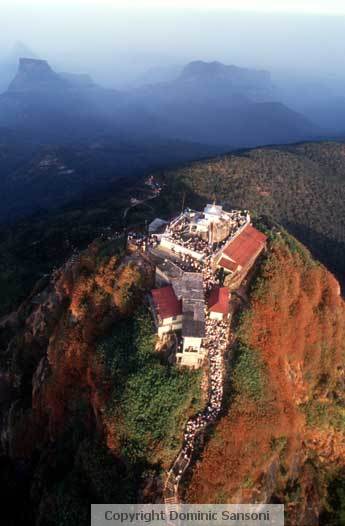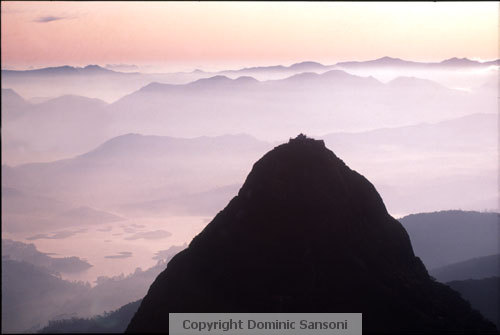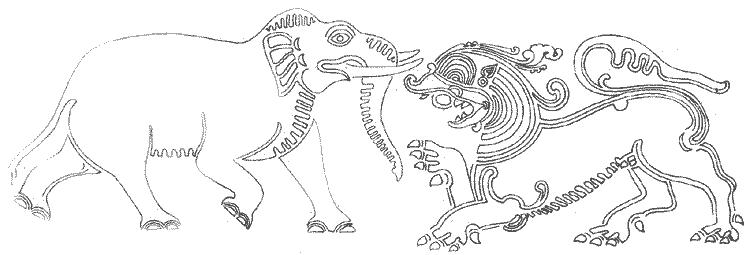Adam's Peak: The Dance of the Rising Sun

by Manik Sandrasagra
Living Heritage Trust of Sri Lanka
The most famous physical feature of Sri Lanka is Adam’s Peak, which is situated in the Ratnapura district. It is on the edge of the central massif but its surrounding group of mountains called the Wilderness of the Peak, is so extensive in comparison to the bulk of the other mountain groups that it appears to form a nucleus of its own, separate from the others. It is about 7,500 feet high and, though it is the second highest peak in the land, its position in relation to the topography is so dominant that it stands out above all others.
The Arabian Nights has possibly the first reference to it:
"Now the island of Serendib lieth under the equinoctial line, its night and day both numbering twelve hours. It measureth eighty leagues long by a breadth of thirty and its width is bounded by a lofty mountain and a deep valley. The mountain is conspicuous from a distance of three days and it contains many rubies and other minerals, and spice trees of all sorts. I ascended that mountain and solaced myself with a view of its marvels which are indescribable and afterwards I returned to the King." (Sixth Voyage of Sindbad the Sailor, from The Thousand and One Arabian Nights)
The pilgrimage usually takes place from December to April, which is the dry season just before the southeast monsoon breaks. The great desire of every pilgrim is to reach the peak before dawn so that they can witness the glorious spectacle of the sunrise and thereafter perform their religious rites. Young and old, married women carrying children, and many old men, who really appear physically incapable of the strenuous effort, make the ascent strengthened by the belief that they are doing an extraordinary meritorious act. For some it is a pleasure trip.

The climb is by no means easy. It takes several hours to get to the top. There are several resting places (madams) at various points on the path, where pilgrims are able to rest, cook and eat their meals or even spend a night. There is a river that separates the peak from the surrounding mountain range in which pilgrims take a ceremonial bath of cleansing and change into clean clothes before crossing over a bridge to the sacred mountain itself. From this point the path is an ascent of steps, very steep at some points. Especially at these and other points iron rails are fixed to support the climbers. Since many pilgrims make the ascent during the night in order to reach the peak before dawn, the pathway is today lit with electricity. Formerly there were only lanterns at various points. Groups of pilgrims sing devotional songs as they climb. Cries of Sadhu sadhu fill the night air and the magic of the mountain envelops the pilgrims as they climb up to heaven along the axis mundi.
A pearl-shaped island in the centre of the Indian Ocean. A single mountain in the central massif rises like a triangle seen far out at sea. A magical forest garlands these central hills, with caves of enlightenment, fountains of immortality, a white tusked elephant, a Himalayan deity called Saman, and the priceless gemstone—the hyacinth—that glowed from an eminence, are just a few of the tales from the “Thus have I heard” story telling tradition that has existed since long before the advent of religions as we know them. This transcendental perspective elevates us beyond the outward, temporal, merely historical aspects of experience and presents an inward dimension of ineffable mystery and wonder.
Enter the labyrinth, the dark night of the soul and seek the Blessed Isle of Balance—Dhammadeepa—as the locals call it: the terrestrial paradise and the divine original that shines like a lamp in the mystic East.
Thomas Mann, in the first volume of his mythological tetralogy Joseph and His Brothers coined the term 'moon grammar' to capture the sense of this order of thought and communication. “Daylight”, he wrote, “is one thing, moonlight another. Things take on a different look beneath the moon and beneath the sun. And it well might be that to the Spirit the light of the moon would appear to yield the truer illumination.” And as Joseph Campbell writes in his monumental The Mythic Image, “It is in this poetic, mystic, spiritual sense that the symbols of the Christian message can be read in concord with those of the other mythological traditions of mankind, and it will therefore be in this sense that we will treat of them in the present work.” So be it with us.
In the beginning, say certain Sri Lankan oral and poetic traditions, our first ancestor descended to earth on this island following a sunbeam and alighted on the summit of this peak, which therefore came to be called Adam’s Peak. Our first ancestor then climbed down the sacred peak and a great multitude of descendents followed this trail, which was originally forged by elephants going down to the plains below. These noble beasts with bells on their feet and blessed by the heavenly court for their wisdom and knowledge were likened to the clouds that ushered the rains.
Most of the cosmographical descriptions of this island, known variously as Taprobane, Serendip, Lanka or Eelam, come to us in the form of oral accounts of the visits of various fabled characters around whom a host of stories has been woven. The Buddha, God Vishnu, War God Skanda-Murugan, the Apostle Thomas, al-Khidr the ‘Green Man’ and mysterious teacher of Moses from Quranic lore, Alexander the Great, merchant-adventurers like Sinbad the Sailor and Marco Polo are all said to have visited island Lanka.
Patrick Harrigan states in "Lanka’s Cosmography Down the Ages" that “More important than issues of the historicity of these visits is the undeniable existence of the stories themselves, for all purport to describe a marvelous isle in terms that reflect a more or less deep awareness of its sacred geographical character and position. Taken together”, he says, “they suggest the existence of an arcane traditional science, known virtually worldwide to a handful of specialists that recognized Lanka as one of its practical paradigms.”
Lanka then is a storybook kingdom, a magical isle of legendary proportions where the unexpected lurks around the corner of every minute, hence the term ‘serendipity’ which originates in Lanka. The southern and southeastern slopes were considered Dakshina or southern Kailasa and the surrounding forests Deviyange Kaele— 'the god’s own forest'. Kataragama in this sacred grove is the seat of a war god who holds court with a retinue of 505 lineage-based hereditary functionaries. The mountains are under the protection of Saman, the presiding deity who is said to ride a white tusker, and whose main shrine is in Ratnapura – the City of Gems. Lanka was a commonwealth of 24,000 villages named after trees and wewas or man-made lakes. Every village had its own shrine often dedicated to a tree spirit. The scent of the virgin jungle with a million varieties of plant life filled the air and rare jewels glittered in the streams that surround the lofty mountain – Adam’s Peak, also called Sri Pāda or resplendent footprint (of Buddha) in Sinhala; and, Sivanoli Pādam in Tamil, which describes it as the sacred footprint of the Hindu god Shiva. For Muslims and Christians the footprint belongs to Adam.
This footprint on the summit that marks the descent is illuminated each day by the dance of the rising sun. From the very beginning, retracing our steps to pay homage to that ideal which annihilates selfhood, has brought countless pilgrims to this sacred mountain who yearn for the grace to be one with the father in heaven – the sun. This chain of transmission is seen everywhere in the form of thread that is wound around the wrists of pilgrims and along the pilgrimage route. White for purity and red for blood and sacrifice; twins symbolized in stone in temples with the union of the elephant and the lion. This union called Gaja-Singha demonstrated wisdom and method. Wisdom and priesthood represented by the elephant, and the method being valour and courage, belonging to the lion and the king. The sacred and the temporal always defined traditional concepts of kingship.
 |
Gaja-Singha, traditional symbol of sacerdotal authority and temporal power. |
The renowned art historian Ananda Coomaraswamy describes self-naughting or akimcanna best. According to him in the vernacular, when a man is presumptuous, we ask him, “Who do you think you are?” and when we refer to someone’s insignificance, we call him a 'nobody' or, in earlier English, a 'nithing'. Coomaraswamy continues “In this worldly sense it is a good thing to be “someone” and a misfortune to be “nobody,” and from this point of view we think well of 'ambition'. To be 'someone' is to have a name and lineage or, at least, to have a place or rank in the world, some distinction that makes us recognizable and conspicuous. Our modern civilization is essentially individualistic and self-assertive, even our educational systems being more and more designed to foster 'self-expression' and 'self-realization'; and if we are at all concerned about what happens after death, it is in terms of the survival of our treasured 'personality' with all its attachments and memories.” On the other hand, he notes, Meister Eckhart, one of the great Christian mystics bridging East and West, the Middle Ages and today, says, “Holy scripture cries aloud for freedom from self.”
All around Adam’s Peak is an affirmation of this primordial truth. The very landscape expresses this revelation, speechlessly spoken by the sun.
Like magic a shadow appears in the air itself and it grows. A giant triangle spreads out over the valleys below. As the sun rises the shadow shrinks, and the two triangles become one like the Seal of Solomon, where the two opposed triangles represent the complementary principles, with all their different applications. This is the most secret of ancient symbols —venerated in this form as the war god Skanda Murugan in Kataragama— a proclamation of the victory of life over death. Going back the way we came. Following trails and tracks like our hunter gatherer ancestors. Such was life.
Pilgrimage repeats the process of reintegration, while the myth belongs to nobody, being the same all over. Life is seen as a dream. Step by step the pilgrim ascends or descends along a sunbeam shedding personality and blessing those they see with words of wisdom.
Summā iru – is the entire truth summā iru – we know nothing summā iru – is happiness.
These words uttered by Tamil speaking tantric siddhas illustrate some of the multiple meanings of the initiatic phrase summā iru also meaning simply be while Sinhala pilgrims repeatedly say karunāwai and sādhu, sādhu while also transferring merit to those on the path through spontaneous verse. From somebody, to nobody, to 'Here Comes Everybody', as James Joyce calls it in Finnegans Wake —this is King Mahasammatta— the great general or the common consensus which was the hallmark of this cooperative culture.
Like mushrooms appearing out of nowhere, the spiral, the vortex and the ascent is also the same everywhere. The serpent energy rises whether it is the mysterious Mount Analogue, Calvary or Adam’s Peak. Humanity wherever it may exist had common myths. The world as a dream, the idea of cosmic order, the lotus and the rose, transformations of the inner light, the sacrifice and the waking is how Joseph Campbell divides his chapters in The Mythic Image. These concepts are the common property of humanity but unfortunately with the Renaissance rationality replaced metaphysics and as a result every mystery became diluted.
Consequently a transcendental experience was denied by formal religions. The snake, like the fish and the cross, are symbols seen throughout the ancient world. Before they were given a historical and material face they were indicative of a hidden meaning. All the great religions began with the myth and then get stuck with history. It is this earth bound history that negates the mystical, making rationality the new doctrine that replaces it.
The ascent starts with purification and the anointing with water. As the ever virgin mother draws its child to its source which is nature’s womb, annihilation of individuality is the goal of the pilgrim, where water plays the role of ritual purification. Entrance to the sacred precinct must begin with purification. Pilgrims climbing Adam’s Peak immerse themselves in the icy cold waters of the rivers cascading from the upper waters of paradise.
Twilight language is the key to understanding these mysteries. In this “Moon Talk” the Tamil summā and the Sinhala nikang are preeminent. They are mantras or sacred utterances in the vulgate. Both these languages have existed in Sri Lanka for centuries having been introduced from continental India by merchants. They have both undergone change with politicization and linkages to ethnicity which has resulted in a twenty year old ethnic strife on the island, but fundamentally they represented giving a name to form. The vernacular spoken Sinhala is quite different to the modern manufactured language that arose as a result of extreme nationalism. However simple villagers still repeat what they have heard and it is this sri mukha pali or ‘moonlight’ version that holds the key.
In Tamil, ecstatic poetry preserved the sacred nature of expression. It is said that higher wisdom can only be expressed by sign of hand speechlessly spoken. This ability of simply being is the real heritage of humanity but with birth and the subsequent fall from grace, separation and suffering follows. The Buddha says that it is caused by greed, hatred and delusion – the roots of ignorance. However the good news is that the reintegration and the return to the edenic state of purity is still possible for all by re–membering that which has been dismembered. Only by simply being is it possible to attain this non-dualistic state of pure bliss where everything is as it is and nothing can be other than what it is, completed and accomplished long ago.
Pilgrimage then is the path to freedom. The French metaphysician Rene Guenon, erroneously called a 'traditionalist' by modernists seeking a new expression for ancient truths, states in “Fundamental Symbols – The Universal language of Sacred Science” that “It is in fact quite obvious that if the cave is the place where initiation itself is accomplished, the labyrinth, site of the preceding trials, can be nothing more than the way that leads to it, as well as the obstacle that bars the unqualified profane from approaching it.”
There are two initiatic ways up the mountain. The path of the gods and path of the ancestors, duality as we know it, contained in breathing with each nostril representing the two passages to the sun and the moon, culminating in the cave of rebirth to be born again and again in an endless game. The symbol of the entwined snakes or the boxers from Crete indicates the same function. It is said that as we breathe the vital air goes down to the base of our spine meeting at points we call chakras and as consciousness arises the intersecting points are pierced and awareness rises to the crown of our heads indicating enlightenment, which was our primordial state of innocence. The dance of the rising sun dispels darkness on this lotus path and cooling grace descends. Now summā or nikang is all there is left. We have reached the summit of experience. The Christian gospel says “Be still and know that I AM God” and “I AM WHO AM.”
In this state the best of all states, having joined the opposites, all duality ceases. Good nor bad nor up nor down, just simply being in the here and now thoughtlessly abiding.
In this age of iron and ignorance, war and conflict are deterrents for the vulgar mind that converts what is sacred into that which is profane. With no understanding of the eternal myth that belongs to all, the modern mentality seeks to divide and redefine the sacred resulting in conflict. All conflict is a result of not seeing life as it is. Pilgrimage reaffirms the original myth and enables each pilgrim to walk the route of his or her preceptor becoming one with those who went before. As the Buddha says “If you see the Dhamma, you see me” and Christ said the same thing when he said “I AM the way the truth and the light. Nobody goes to the Father except through ME.” The initiative mantra is I AM and ME and not a historical entity, hence each pilgrim carries his or her own cross.
Individuality like rivers being absorbed into the vastness of the sea. ‘Here Comes Everybody’ or King Mahasammata comes down the hill. The Great General—the common purpose— the commonsense of the common folk. How can this tale be told other than through metaphor and allusion?
Even in Paradise there was a serpent that kept the faint hearted at bay. This tale is only for an awakened elite — the Arya Sangha — who have ears to hear and eyes to see. As Shakespeare says in Hamlet “There’s a special providence in the fall of a sparrow. If it be now, ‘tis not to come, if it is not to come, it will be now, if it is not now, yet it will come: the readiness is all.”
Thus Have I heard… Evan me suttang.